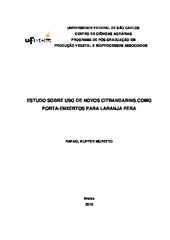| dc.contributor.author | Moretto, Rafael Kupper | |
| dc.date.accessioned | 2019-08-14T19:39:27Z | eng |
| dc.date.available | 2019-08-14T19:39:27Z | eng |
| dc.date.issued | 2019-05-31 | eng |
| dc.identifier.citation | MORETTO, Rafael Kupper. Estudo sobre uso de novos citrandarins como porta-enxertos para laranja pera. 2019. Dissertação (Mestrado em Produção Vegetal e Bioprocessos Associados) – Universidade Federal de São Carlos, Araras, 2019. Disponível em: https://repositorio.ufscar.br/handle/ufscar/11742. | * |
| dc.identifier.uri | https://repositorio.ufscar.br/handle/ufscar/11742 | por |
| dc.description.abstract | Currently, the most of the citrus plants in the Brazil are on the rootstocks Rangpur lime and Swingle citrumelo, which may put at risk the Brazilian citriculture by the use of few genotypes. The use of other rootstocks such as Poncirus trifoliata is limited due to the occurrence of incompatibility between selections of this rootstock and Pera sweet orange, in addition to the susceptibility to drought. Therefore, the use of citrandarins [Sunki mandarin (Citrus sunki Hort. Ex Tan.) X Poncirus trifoliata (L.) Raf.] constitute a new generation of rootstocks, which present potential as an alternative to the use of Rangpur lime, enabling the formation of long-lived plants and conferring to the canopy production and quality of satisfactory fruits. In view of the above, the present work had the objective of evaluating the development of Pera sweet orange plants, regarding their vegetative development; physical and chemical characteristics of the fruits; to phenology and compatibility, when grafted on different varieties and rootstock hybrids, in two different edaphoclimatic conditions. The experiments are established in two municipalities of the State of São Paulo, Gavião Peixoto and Barretos and, in a randomized blocks statistical design. The data obtained in this study showed that the production of orange Pera on the citrandarins in the region of Gavião Peixoto, was 15% larger than in the Barretos region. It can be observed that the different edaphoclimatic conditions presented in the two regions influenced the behavior of rootstocks regarding fruit fixation and yield, and that the most important rootstock was citrandarin128. | eng |
| dc.description.sponsorship | Coordenação de Aperfeiçoamento de Pessoal de Nível Superior (CAPES) | por |
| dc.language.iso | por | por |
| dc.publisher | Universidade Federal de São Carlos | por |
| dc.rights.uri | Acesso aberto | por |
| dc.subject | Melhoramento | por |
| dc.subject | Híbridos | por |
| dc.subject | Citros | por |
| dc.subject | Enhancement | eng |
| dc.subject | Hybrids | eng |
| dc.subject | Citrus | eng |
| dc.title | Estudo sobre uso de novos citrandarins como porta-enxertos para laranja pera | por |
| dc.title.alternative | Study of new citrandarins as rootstocks to pera sweet orange | eng |
| dc.type | Dissertação | por |
| dc.contributor.advisor1 | Cristofani-Yaly, Mariângela | |
| dc.contributor.advisor1Lattes | http://lattes.cnpq.br/7829946393687571 | por |
| dc.description.resumo | Atualmente, a maior parte das plantas cítricas do Brasil está sobre os porta-enxertos limão Cravo e citrumelo Swingle, o que pode colocar em risco a citricultura brasileira, pela baixa diversidade genética. A utilização de outros porta-enxertos, como o Poncirus trifoliata é limitada, devido à ocorrência de incompatibilidade entre seleções deste porta-enxerto e a laranja Pera, além da suscetibilidade à seca. Portanto, a utilização de citrandarins [tangerina Sunki (Citrus sunki Hort. ex Tan.) x Poncirus trifoliata (L.) Raf.] apresenta-se como alternativa, possibilitando a formação de plantas longevas e conferindo à copa produção e qualidade de frutos satisfatórias. Diante do exposto, o presente trabalho teve por objetivo avaliar o desempenho de plantas de laranja Pera, quanto ao seu desenvolvimento vegetativo; às características físico-químicas dos frutos; à fenologia e compatibilidade, quando enxertadas sobre diferentes variedades e híbridos de porta-enxertos, em duas diferentes condições edafoclimáticas. Os experimentos estão estabelecidos em dois municípios do estado de São Paulo, Gavião Peixoto e Barretos e, em um delineamento estatístico em blocos casualizados. Os dados obtidos neste estudo mostraram que a produção de laranja Pera sobre os citrandarins, na região de Gavião Peixoto, se mostrou 15% maior do que na região de Barretos. Pode se observar que as diferentes condições edafoclimáticas apresentadas nas duas regiões influenciaram o comportamento dos porta-enxertos quanto à fixação de frutos e, consequentemente, o porta-enxerto que mais se destacou, na produção acumulada de 2017 e 2018, foi o citrandarin 128. | por |
| dc.publisher.initials | UFSCar | por |
| dc.publisher.program | Programa de Pós-Graduação em Produção Vegetal e Bioprocessos Associados - PPGPVBA-Ar | por |
| dc.subject.cnpq | CIENCIAS AGRARIAS::AGRONOMIA | por |
| dc.ufscar.embargo | Online | por |
| dc.publisher.address | Câmpus Araras | por |
